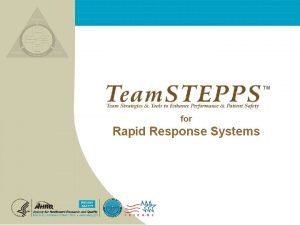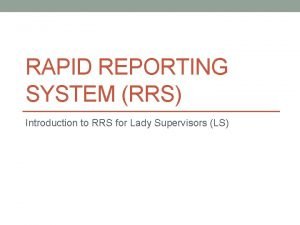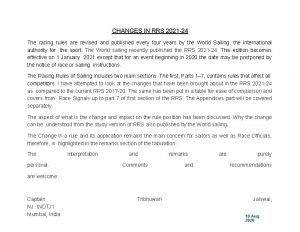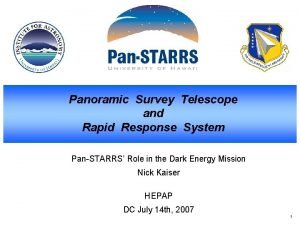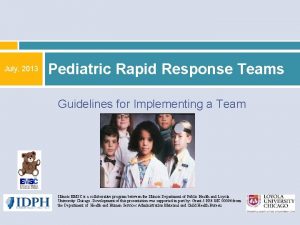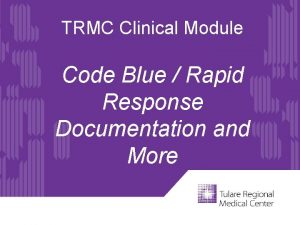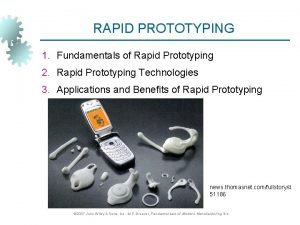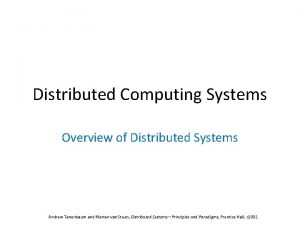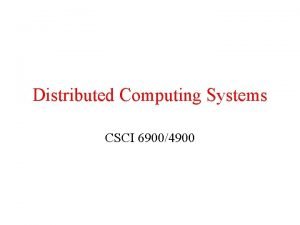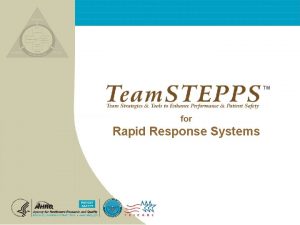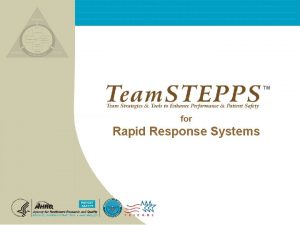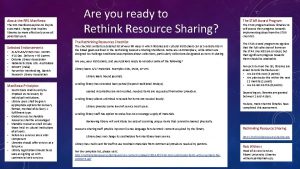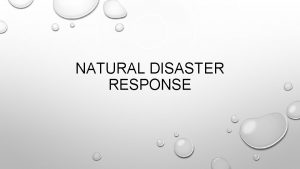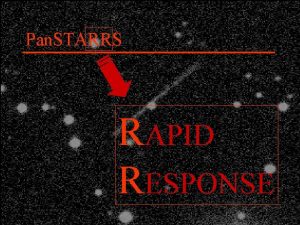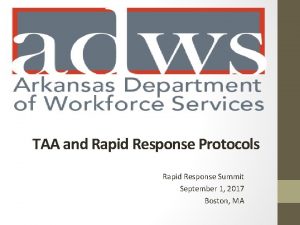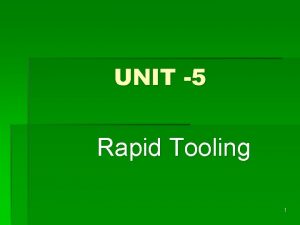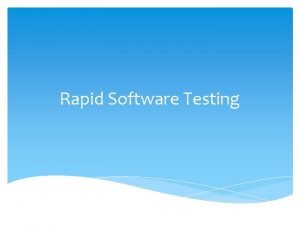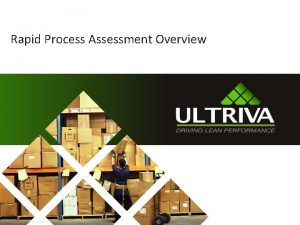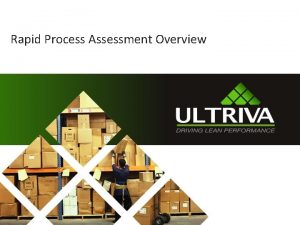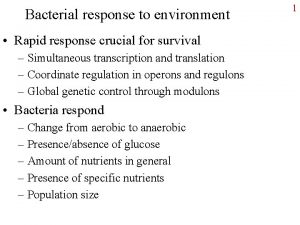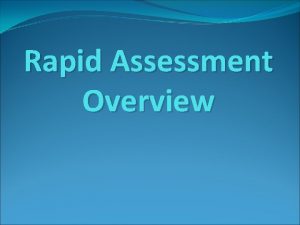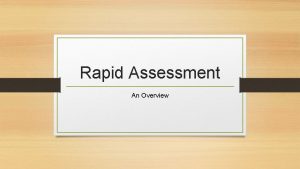TM for Rapid Response Systems RRS Overview n




















































- Slides: 52

TM for Rapid Response Systems

RRS Overview n What is the Rapid Response System? n The Rapid Response System (RRS) is the overarching structure that coordinates all teams involved in a rapid response call n What is Team. STEPPS? Mod 1205. 2 Page n The Agency for Healthcare Research and Quality’s curriculum and materials for teaching teamwork tools and strategies to healthcare professionals n This module of Team. STEPPS is for RRS TEAMSTEPPS 05. 2

RRS Overview n What is the Rapid Response Team? Mod 1305. 2 Page 3 Page n RRS has several parts, one of them being the Rapid Response Team (RRT) n A RRT – known by some as the Medical Emergency Team – is a team of clinicians who bring critical care expertise to the patient’s bedside or wherever it is needed (IHI, 2007) TEAMSTEPPS 05. 2

RRS Why Should You Care? n People die unnecessarily every day in our hospitals n It is likely that each of you can provide an example of a patient who, in retrospect, should not have died during his or her hospitalization n There are often clear early warning signs of deterioration n Establishing a RRS is one of the Joint Commission’s 2008 National Patient Safety Goals n Teamwork is critical to successful rapid response n The evidence suggests that RRS work! Mod 1405. 2 Page 4 Page TEAMSTEPPS 05. 2

RRS Does it Work? Before After No. of cardiac arrests 63 22 Deaths from cardiac arrest 37 16 No. of days in ICU post arrest 163 33 No. of days in hospital after arrest 1363 159 Inpatient deaths 302 222 Bellomo R, Goldsmith D, Uchino S, et al. A prospective before-and-after trial of a medical emergency team. Medical Journal of Australia. 2003; 179(6): 283 -287. Mod 1505. 2 Page 5 Page TEAMSTEPPS 05. 2

RRS Does the RRS Work? n 50% reduction in non-ICU arrests Buist MD, Moore GE, Bernard SA, Waxman BP, Anderson JN, Nguyen TV. Effects of a medical emergency team on reduction of incidence of and mortality from unexpected cardiac arrests in hospital: preliminary study. BMJ. 2002; 324: 387 -390. n Reduced post-operative emergency ICU transfers (58%) and deaths (37%) Bellomo R, Goldsmith D, Uchino S, et al. Prospective controlled trial of effect of medical emergency team on postoperative morbidity and mortality rates. Crit Care Med. 2004; 32: 916 -921. n Reduction in arrest prior to ICU transfer (4% vs. 30%) Goldhill DR, Worthington L, Mulcahy A, Tarling M, Sumner A. The patient-at-risk team: identifying and managing seriously ill ward patients. Anesthesia. 1999; 54(9): 853 -860. n 17% decrease in the incidence of cardiopulmonary arrests (6. 5 vs. 5. 4 per 1000 admissions) De. Vita MA, Braithwaite RS, Mahidhara R, Stuart S, Foraida M, Simmons RL. Use of medical emergency team responses to reduce hospital cardiopulmonary arrests. Qual Saf Health Care. 2004; 13(4): 251 -254. Mod 1605. 2 Page 6 Page TEAMSTEPPS 05. 2

RRS NQF Safe Practices n In 2003, the National Quality Forum (NQF) identified the RRS as a chief example of a team intervention serving the safe practice element of Team Training and Team Interventions n RRSs are viewed as an ideal example of safe practices in teamwork meeting the objective of establishing a proactive systemic approach to team-based care n In 2006, the NQF updated their Safe Practices recommendations n Mod 1705. 2 Page 7 Page NQF continues to endorse RRSs and concludes that annually organizations should formally evaluate the opportunity for using rapid response systems to address the issues of deteriorating patients (NQF, 2006) TEAMSTEPPS 05. 2

RRS Joint Commission 2008 National Patient Safety Goal n Goal 16: Improve recognition and response to changes in a patient’s condition n Mod 1805. 2 Page 8 Page 16 A. The organization selects a suitable method that enables health care staff members to directly request additional assistance from a specially trained individual(s) when the patient’s condition appears to be worsening TEAMSTEPPS 05. 2

RRS Implementation n When implementing RRS, the Institute for Healthcare Improvement (IHI) recommends: n Engaging senior leadership n Identifying key staff for RRTs n Establishing alert criteria and a mechanism for calling the RRT n Educating staff about alert criteria and protocol n Using a structured documentation tool n Establishing feedback mechanisms n Measuring effectiveness n RRS can be customized to meet your institutions’ needs and resources Mod 1905. 2 Page 9 Page TEAMSTEPPS 05. 2

RRS Structure Mod 110 Page 05. 2 Page 10 TEAMSTEPPS 05. 2

RRS Activator(s) n Activators can be: Mod 111 Page 05. 2 Page 11 n Floor staff n A technician n The patient n A family member n Specialists n Anyone sensing the acute deterioration TEAMSTEPPS 05. 2

RRS Responder(s) n Responders come to the bedside and assess the patient’s situation n Responders determine patient disposition, which could include: n n n Transferring the patient to another critical care unit (e. g. , ICU or CCU) A handoff back to the primary nurse/primary physician Revising the treatment plan n Activators may become Responders and assist in stabilizing the patient Mod 112 Page 05. 2 Page 12 TEAMSTEPPS 05. 2

RRS Activators & Responders n Activator(s) are responsible for calling the Responder(s) if a patient meets the calling criteria n Responders must reinforce the Activator(s) for calling: “Why did you call? ” vs. “Thank you for calling. What is the situation? ” Remember: There are no “bad calls”! Mod 113 Page 05. 2 Page 13 TEAMSTEPPS 05. 2

RRS Support: Quality Improvement & Administration n The Quality Improvement (QI) Team supports Activators and Responders by reviewing RRS events and evaluating data for the purpose of improving RRS processes n The Administration Team of the RRS brings organizational resources, support, and leadership to the entire RRS and ensures that changes in processes are implemented if necessary Mod 114 Page 05. 2 Page 14 TEAMSTEPPS 05. 2

RRS Let’s Watch the RRS in Action Mod 115 Page 05. 2 Page 15 TEAMSTEPPS 05. 2

RRS Teamwork & RRS n The RRS has all these barriers to effective care: Conflict Lack of coordination Distractions Fatigue Workload Misinterpretation of cues Lack of role clarity Inconsistency in team membership Lack of time Lack of information sharing Mod 116 Page 05. 2 Page 16 TEAMSTEPPS 05. 2

RRS Necessary Teamwork Skills Mod 117 Page 05. 2 Page 17 TEAMSTEPPS 05. 2

RRS Inter-Team Knowledge n Supports effective transitions in care between units n Is a prerequisite for transition support (or “boundary spanning”) n Consists of understanding the roles and responsibilities of each team within the RRS Mod 118 Page 05. 2 Page 18 TEAMSTEPPS 05. 2

RRS Inter-Team Knowledge Activator needs… ICU requires… Administration requires… Patient needs… Responders need… ICU requires… n In the RRS, inter-team s n tra tio in is Ad m t y lit en ua m Q ove pr TEAMSTEPPS 05. 2 r de on Teamwork Im Mod 119 Page 05. 2 Page 19 o at iv t c A n Activators must know the roles and responsibilities of Responders and vice versa p es rs R knowledge means all RRS members possess a shared understanding of the roles and responsibilities of all other members

RRS Transition Support (“Boundary Spanning”) n Requires inter-team knowledge n Combines monitoring transitions in care and providing backup behavior when needed n Provides role support n Mod 120 Page 05. 2 Page 20 Example: Activator becoming Responder TEAMSTEPPS 05. 2

RRS Transition Support (“Boundary Spanning”) § Manage data nd po es a iv ct § Monitor transitions R s r to s er A § Educate staff on situation and roles Mod 121 Page 05. 2 Page 21 in is Ad m t y lit en ua m Q ove pr Im tra tio n § Ensure data recording TEAMSTEPPS 05. 2 § Assist in role orientation

RRS Example of One RRS n Activators call Responders using a pager n Who are the Responders? Mod 122 Page 05. 2 Page 22 n ICU Physician n ICU Charge Nurse n Nurse Practitioner (if available) n RRS coordinator n Transportation service n For Pediatric Unit, chaplain’s office, security, and respiratory therapist are also included TEAMSTEPPS 05. 2

RRS Example of One RRS (continued) n Training n Includes direct teaching modules on rapid response and practice using Situation-Background-Assessment. Recommendation (SBAR) Online training modules n Single-discipline training sessions n n Data Collection includes reporting: n Who called the response team and what criteria were used? n Who responded and in what timeframe? What was done for the patient? What are the top 5 diagnoses seen in the RRS? n n Mod 123 Page 05. 2 Page 23 TEAMSTEPPS 05. 2

RRS Example of Another RRS n Activators call Responders using an overhead page and a pager n Family members are considered Activators n Responders include: Mod 124 Page 05. 2 Page 24 n Nursing staff n Respiratory care staff n ICU staff TEAMSTEPPS 05. 2

RRS Example of Another RRS (continued) n Training n In-class sessions n Simulation center n Interdisciplinary training in same location n Data collection Mod 125 Page 05. 2 Page 25 n Event debriefing n Task-oriented checklist by roles TEAMSTEPPS 05. 2

RRS Example of Another RRS (continued) Nursing Tasks Completed? 1. Check the patient’s pulse. 2. Obtain vital signs. 3. Place the pulse oximeter. 4. Assess patient’s IVs. Respiratory Therapist Tasks Mod 126 Page 05. 2 Page 26 Completed? 1. Assess the airway. 2. Count the respiratory rate. 3. Assist ventilation. 4. Check the patient’s pupils. TEAMSTEPPS 05. 2

RRS Exercise I: Let’s Identify Your RRS Structure Think about the four components of the RRS: Activators, Responders, QI and Administrative n Who are the Activators? n What are the alert criteria? n How are Responders called? What do Activators do once Responders arrive? n n Mod 127 Page 05. 2 Page 27 Who are the Responders? n How many Responders arrive to a call? n What is each person’s role? TEAMSTEPPS 05. 2

RRS Exercise I (continued): Let’s Identify Your RRS Structure n What are the common challenges facing your RRS? n Are there challenges during: Mod 128 Page 05. 2 Page 28 n Patient deterioration? n System activation? n Patient handoffs? n Patient treatment? n Evaluation of the response team? TEAMSTEPPS 05. 2

RRS Execution Mod 129 Page 05. 2 Page 29 TEAMSTEPPS 05. 2

RRS Detection Tools/Strategies HUDDLE STEP Activator sees signs of acute deterioration before actual deterioration Situation Monitoring DETECTION Mod 130 Page 05. 2 Page 30 TEAMSTEPPS 05. 2

RRS Detection: STEP Assessment Use your institution’s detection criteria for RRS activation Is it time to activate the RRS? Mod 131 Page 05. 2 Page 31 TEAMSTEPPS 05. 2

RRS Where can Detection occur? n Detection can occur from a variety of sources or concerns Mod 132 Page 05. 2 Page 32 TEAMSTEPPS 05. 2

RRS Activation Communication Tools/Strategies SBAR Mod 133 Page 05. 2 Page 33 TEAMSTEPPS 05. 2

RRS Activation: SBAR n SBAR provides a framework for team members to effectively communicate information to one another n Communicate the following information: n Situation―What is going on with the patient? n Background―What is the clinical background or context? n Assessment―What do I think the problem is? n Recommendation/Request―What would I recommend/request? Remember to introduce yourself… Mod 134 Page 05. 2 Page 34 TEAMSTEPPS 05. 2

RRS Response, Assessment & Stabilization Tools/Strategies: Leadership Brief Huddle Responders analyze patient condition; attempt to stabilize RESPONSE, ASSESSMENT & STABILIZATION Mod 135 Page 05. 2 Page 35 Leadership, Situation Monitoring, Mutual Support, Communication, & Inter-Team Knowledge RESPONSE, ASSESSMENT & STABILIZATION TEAMSTEPPS 05. 2 Tools/Strategies: Communication Check-back Call Out Tools/Strategies: Mutual Support Task Assistance CUS

RRS Response, Assessment & Stabilization Huddle Devise contingencies for sending the patient to the ICU or other ancillary units. Devise contingencies for a handoff back to the general care area (i. e. , keeping the patient in current location). Mod 136 Page 05. 2 Page 36 TEAMSTEPPS 05. 2

RRS Response, Assessment & Stabilization CUS Words Mod 137 Page 05. 2 Page 37 TEAMSTEPPS 05. 2

RRS Patient Disposition Communication Tools/Strategies Handoffs SBAR I PASS the BATON Mod 138 Page 05. 2 Page 38 TEAMSTEPPS 05. 2

RRS Patient Disposition n Disposition can refer to a number of decisions, including: Mod 139 Page 05. 2 Page 39 n Transferring the patient to another unit n A handoff back to the primary nurse/primary physician (i. e. , patient stays in same location) n A handoff to a specialized team (cardiac team, code team, stroke team, etc) n A revised plan of care TEAMSTEPPS 05. 2

RRS Transition: I PASS the BATON Mod 140 Page 05. 2 Page 40 TEAMSTEPPS 05. 2

RRS Evaluation Tools/Strategies Activators, Responders, Admin & QI Components evaluate performance and assess data for process improvement Leadership, Sensemaking & Communication EVALUATION Mod 141 Page 05. 2 Page 41 TEAMSTEPPS 05. 2 Debriefs Sensemaking Checklist

RRS Evaluation: Debriefs n Debriefs occur right after the event and are conducted by the Responders n Debriefs should address: Mod 142 Page 05. 2 Page 42 n Roles n Responsibilities n Tasks n Emphasis on transitions in care n Achievement of patient stabilization TEAMSTEPPS 05. 2

RRS System Evaluation: Sensemaking Review Sheet 1. How did the Activators and Responders react to this situation? 2. When looking at the “big picture, ” are there any patterns or trends? Mod 143 Page 05. 2 Page 43 TEAMSTEPPS 05. 2

RRS System Evaluation: Sensemaking Tools n Proactive approaches n n Failure Modes and Effects Analysis (FMEA) Probabilistic Risk Assessment (PRA) n Reactive approaches n Root Cause Analysis (RCA) Integrated Sensemaking Approach n What can go wrong? n What are the consequences? n How do things go wrong? n How likely are they? n What went wrong? n Why did it go wrong? Mod 144 Page 05. 2 Page 44 TEAMSTEPPS 05. 2

RRS Let’s look back at our example Mod 145 Page 05. 2 Page 45 TEAMSTEPPS 05. 2

RRS Exercise II: RRS Execution n Using the scenario provided, identify the five phases of the RRS and what tools and/or strategies were used during each phase n Detection n Activation n Response, Assessment, and Stabilization n Disposition n Evaluation Mod 146 Page 05. 2 Page 46 TEAMSTEPPS 05. 2

RRS Exercise III n Let’s see if we can identify the tools needed or used in each example n Scenario 1 n Scenario 2 n Scenario 3 n Scenario 4 n Scenario 5 Mod 147 Page 05. 2 Page 47 TEAMSTEPPS 05. 2

RRS Scenario 1 The nurse called the RRT to a patient who exhibited a reduced respiratory rate. The team was paged via overhead page. Within several minutes, team members arrived at the patient’s room; however, the respiratory therapist did not arrive. After a second overhead page and other calls, the respiratory therapist arrived, stating that he could not arrive sooner due to duties in the ICU. This critical team member did not ascribe importance to the rapid response call and failed to provide a critical skill during a rapid response event. As a result, there was a delay in the assessment of the patient’s airway and intervention pending arrival of the response respiratory therapist. Mod 148 Page 05. 2 Page 48 TEAMSTEPPS 05. 2

RRS Scenario 2 The RRT was called for a patient who had a risk of respiratory failure. The patient was intubated and transferred to a higher level of care. Response team members and the nurse who called the team completed a Call Evaluation Form. The response team members noted that some supplies, such as nonrebreather masks and an intubation kit, were not readily available on the floor, which resulted in a delay. This delay could have impacted the patient, and it also affected the team members’ ability to return to their patient assignments. The patient’s nurse noted on the form that the response team seemed agitated by the lack of supplies and the delay. The evaluation forms were sent via interdepartmental mail to the quality department as indicated on the form. The forms were not collated or reviewed for several weeks. The analyst responsible felt that most of the reports prepared in the past were not used by or of interest to management. Several times the agenda item for RRS updates had been removed from the Quality Council’s meeting agenda due to an expectation that the “Rapid Response System is running fine. ” Mod 149 Page 05. 2 Page 49 TEAMSTEPPS 05. 2

RRS Scenario 3 A family member noticed the patient seemed lethargic and confused. The family member alerted the nurse about these concerns. The nurse assured the family member that she would check on the patient. An hour later, the family member reminded the nurse, who then assessed the patient. The nurse checked the patient’s vital signs. She did note any specific change in clinical status, though she agreed that the patient seemed lethargic. At the family member’s urging, the nurse contacted the physician, but the conversation focused on the family member’s insistence that the nurse call the physician rather than conveying a specific description of the patient’s condition. Based on the unclear assessment, the physician did not have specific instructions. The physician recommended additional monitoring. Another nurse on the floor suggested calling the RRT, which she heard had helped with this type of situation on another floor. The first nurse missed the training about the new RRS, which was not discussed in staff meetings. Based on her colleague’s recommendation, the nurse called the RRT via the operator. The overhead page stated the unit where assistance was needed but not the patient’s room number. The operator forgot to take down all of the usual information because he missed lunch and was distracted. The team arrived on the floor but had to wait to be directed to the appropriate room. Once there, the RRT received a brief overview from the nurse, who left the room shortly afterward. The responders conducted an assessment of the patient and identified that the patient was overmedicated. Mod 150 Page 05. 2 Page 50 TEAMSTEPPS 05. 2

RRS Scenario 4 The RRT was called to the outpatient (OP) area for a report of a patient with a seizure. The usual or expected set of supplies was not available for the team in the OP area. The RRT arrived and assessed the patient. As part of the assessment, the team ordered a stat lab. The lab technician working with the OP area had not heard of the RRS and refused to facilitate a stat lab because he was unfamiliar with having this need in an OP area. The RRT members were frustrated but did not challenge the lab technician. The patient was taken to the Emergency Department. Mod 151 Page 05. 2 Page 51 TEAMSTEPPS 05. 2

RRS Scenario 5 A night nurse noted that a patient who had been on the unit for 2 days seemed more tired than usual. Although the patient was usually responsive and animated, she did not seem as responsive during the evening shift. After checking on her twice, the nurse noted that the patient seemed weak and confused. The nurse called the physician at 3 a. m. and described the patient’s general status change as being “not quite right” but did not provide a detailed report or recommendation. The physician, frustrated, did not ask probing questions about the patient. The physician noted that it was 3 a. m. , mentioned that perhaps the patient was tired, and instructed the nurse to monitor the patient. The next morning, the physician came in to do rounds and could not find a complete update from the previous evening. Upon assessing the patient, the physician ordered a stat MRI to rule out stroke. The nurse experienced anxiety due to deterioration of patient status and inability to communicate with the physician. The physician was frustrated by not clearly receiving all of the relevant patient information during the first physician-nurse communication. The patient’s stroke remained unidentified during evening shift. Mod 152 Page 05. 2 Page 52 TEAMSTEPPS 05. 2
 Rrs example
Rrs example Rapid reporting system
Rapid reporting system Rrs 2021-24
Rrs 2021-24 Rrs example
Rrs example Surge and rapid response team salary
Surge and rapid response team salary Panoramic survey telescope and rapid response system
Panoramic survey telescope and rapid response system Panoramic survey telescope and rapid response system
Panoramic survey telescope and rapid response system Pediatric rapid response team
Pediatric rapid response team Rapid response documentation
Rapid response documentation Oem solid based rapid prototyping
Oem solid based rapid prototyping Distributed systems overview
Distributed systems overview Sap easy cost planning
Sap easy cost planning Introduction to distributed computing
Introduction to distributed computing Dual mode in os
Dual mode in os Operating system overview
Operating system overview Natural and forced response
Natural and forced response Natural response circuit
Natural response circuit A subsequent
A subsequent Formuö
Formuö Novell typiska drag
Novell typiska drag Nationell inriktning för artificiell intelligens
Nationell inriktning för artificiell intelligens Returpilarna
Returpilarna Shingelfrisyren
Shingelfrisyren En lathund för arbete med kontinuitetshantering
En lathund för arbete med kontinuitetshantering Särskild löneskatt för pensionskostnader
Särskild löneskatt för pensionskostnader Tidbok
Tidbok Sura för anatom
Sura för anatom Förklara densitet för barn
Förklara densitet för barn Datorkunskap för nybörjare
Datorkunskap för nybörjare Stig kerman
Stig kerman Debatt artikel mall
Debatt artikel mall Autokratiskt ledarskap
Autokratiskt ledarskap Nyckelkompetenser för livslångt lärande
Nyckelkompetenser för livslångt lärande Påbyggnader för flakfordon
Påbyggnader för flakfordon Lufttryck formel
Lufttryck formel Svenskt ramverk för digital samverkan
Svenskt ramverk för digital samverkan Jag har nigit för nymånens skära text
Jag har nigit för nymånens skära text Presentera för publik crossboss
Presentera för publik crossboss Jiddisch
Jiddisch Bat mitza
Bat mitza Klassificeringsstruktur för kommunala verksamheter
Klassificeringsstruktur för kommunala verksamheter Mjälthilus
Mjälthilus Bästa kameran för astrofoto
Bästa kameran för astrofoto Cks
Cks Programskede byggprocessen
Programskede byggprocessen Bra mat för unga idrottare
Bra mat för unga idrottare Verktyg för automatisering av utbetalningar
Verktyg för automatisering av utbetalningar Rutin för avvikelsehantering
Rutin för avvikelsehantering Smärtskolan kunskap för livet
Smärtskolan kunskap för livet Ministerstyre för och nackdelar
Ministerstyre för och nackdelar Tack för att ni har lyssnat
Tack för att ni har lyssnat Referatmarkeringar
Referatmarkeringar Redogör för vad psykologi är
Redogör för vad psykologi är
